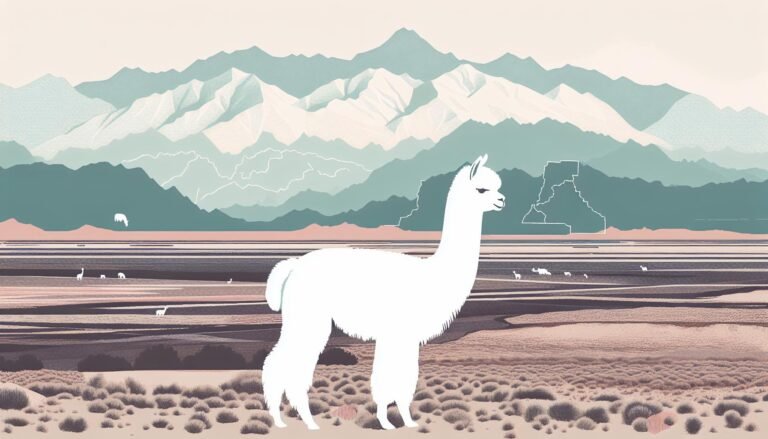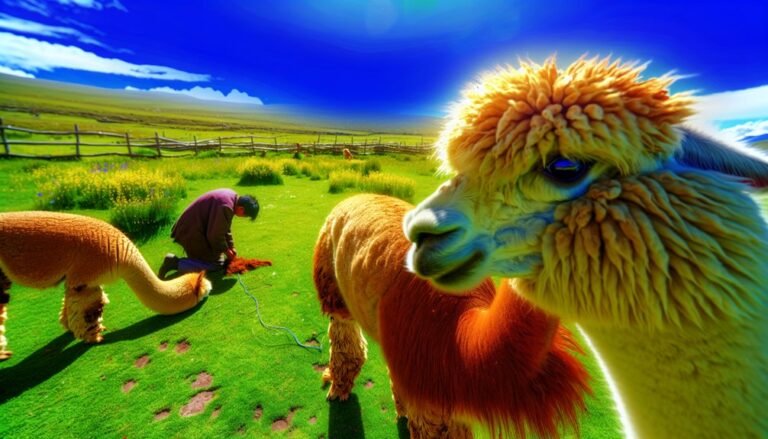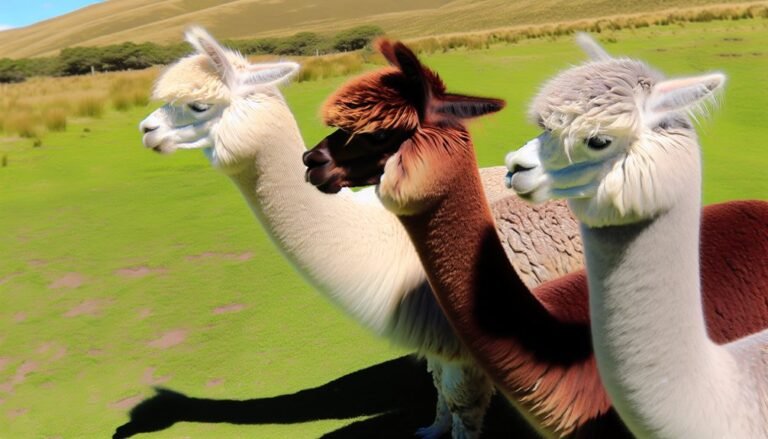Why Do Some Alpacas Produce More Fiber?
You’ll find some alpacas produce more fiber because of their genetics, which influence fleece density and fineness. Proper nutrition, especially protein and minerals, boosts fiber growth, while good health and low stress keep production steady. Younger alpacas and cooler climates can enhance fiber quality too. Different breeds, like Huacayas and Suris, also vary in fiber amount and type. Understanding these factors helps you see why fiber output differs among alpacas and what affects their fleece yield.
Key Takeaways
- Genetic traits strongly influence fiber production, with superior genetics yielding finer, denser fleece and higher fiber output.
- Balanced nutrition rich in proteins, amino acids, and minerals boosts fiber growth and quality significantly.
- Health status and low stress levels maintain hormonal balance, promoting consistent fiber growth and higher yields.
- Younger alpacas, especially between ages 2 and 5, produce finer and more abundant fiber compared to older animals.
- Breed differences affect fiber density; Huacaya alpacas typically produce denser, more fiber than less dense Suri types.
Genetic Factors Influencing Fiber Production

Although environmental conditions matter, genetic factors play an essential role in how much fiber an alpaca produces. If you’re an alpaca breeder, understanding these genetic factors is vital for improving fiber production. Alpacas with superior genetic traits typically yield finer, denser fleece. Selective breeding focuses on traits like fiber diameter and density, with studies showing up to 30-40% of fiber production variation stems from genetics. When you select alpacas from high-yielding lineages, you’re more likely to see improved growth rates and fleece characteristics in their offspring. Advances in genetic marker research also help alpaca breeders identify and select animals with desirable fiber traits more efficiently, making breeding programs more effective and boosting overall fiber production in your herd.
Nutritional Impact on Fiber Growth
Since nutrition directly affects an alpaca’s fiber growth, providing a balanced diet rich in carbohydrates, proteins, vitamins, and minerals is essential for boosting fiber production. The nutritional impact on alpaca fibers is significant—feeding high-quality forage like protein-rich legumes can increase fiber yield by up to 30%. Key nutrients, especially amino acids such as lysine, support keratin formation, which is vital for strong, fine fibers. Minerals like zinc and copper also enhance fleece quality by aiding hair follicle development. However, poor nutrition or overfeeding may lead to more coarse guard hairs instead of fine fibers, reducing fleece value. By managing your alpaca’s diet carefully, you can optimize fiber production and improve both the quantity and quality of their fleece.
Role of Health and Stress in Fleece Yield
When you consider fleece yield, an alpaca’s overall health and stress levels play a major role in fiber production. If your alpacas are unhealthy or malnourished, their fiber production will drop markedly. Chronic stress—caused by environmental shifts or herd social tensions—disrupts hormonal balance, reducing fiber growth rates. This leads to both lower quality and smaller quantities of fleece during shearing. To boost fiber production, you’ll want to maintain proper nutrition and regular veterinary care, ensuring your alpacas stay healthy. Creating a stable, calm environment minimizes stress, improving fleece yield. Additionally, selecting breeding stock with genetic resilience to stress helps produce healthier animals that naturally yield more fiber. By focusing on health and managing stress, you’ll considerably enhance your alpacas’ fiber production.
Age and Environmental Effects on Fiber Quality

Younger alpacas usually produce finer, softer fiber, with the best quality found between ages 2 and 5, as fiber diameter tends to increase as they get older. When considering fiber quality, both age and environmental factors play significant roles. Here’s what you should keep in mind:
- Age: As alpacas age beyond 5, fiber becomes coarser, reducing softness and value.
- Environmental factors: Nutrition and low stress boost fiber quality, so a well-managed alpaca thrives.
- Climate: Cooler environments encourage denser, warmer fleece, enhancing fiber characteristics.
Parasites or diseases can also harm fiber production, so maintaining a healthy environment is essential. By understanding how age and environmental factors affect fiber quality, you can better manage your alpacas for ideal fleece yield and softness.
Breed Differences and Fiber Density
Although both Huacaya and Suri alpacas produce valuable fiber, their fleece differs significantly in density and texture. Huacaya fiber is denser and crimpier, resulting in a higher fiber density and more fiber produced per animal. In contrast, Suri fiber has a silky appearance with long, pencil-like locks but tends to be less dense, contributing to a lower overall fiber yield. Since only about 19-20% of North American alpacas are Suris, the total fiber output from this breed is lower. When you’re considering fiber production, breed differences like these matter. Selective breeding can also affect fiber density, often trading off quantity for fineness. Ultimately, if you want more fiber, Huacaya alpacas usually offer a greater fiber density advantage over Suris.
Frequently Asked Questions
How Much Fiber Does One Alpaca Produce?
You might think alpacas produce endless fiber like magic, but they average 5-10 pounds yearly. Fiber production factors, fiber quality differences, and alpaca breeding practices all play roles in how fluffy your alpaca gets.
What Is Unique About Alpaca Fiber?
You’ll love alpaca fiber’s unique properties—it’s soft, durable, and hypoallergenic. Different fiber grades affect fiber uses, from fine garments to warm blankets, making alpaca fiber versatile and highly prized in textiles worldwide.
What Is the Best Alpaca Fiber?
You’ll find the best alpaca fiber, called Royal Alpaca, has exceptional fiber characteristics—fine, soft, and comfortable. Its quality enhances fiber processing and suits luxury fiber applications, like warm sweaters or silky woven fabrics, perfectly.
Is Alpaca Fiber Better Than Wool?
You’ll love that alpaca fiber is three times warmer than wool, offering amazing alpaca fiber benefits. Compared to wool, its fiber quality is softer, hypoallergenic, and more durable, making it a superior choice in wool comparison.







Our picks
Alpaca & Wool Felted Sole Inserts: Comfy Upgrade?
Best Alpaca Socks for Hiking: Ultimate Comfort and Durability on Trails
Best Alpaca Halter for Comfort and Control